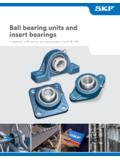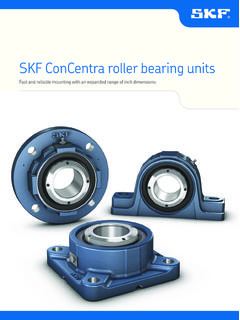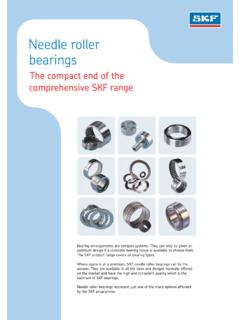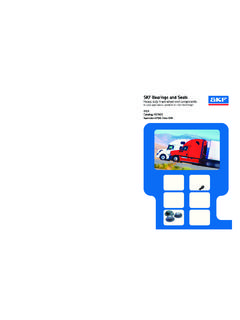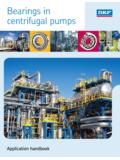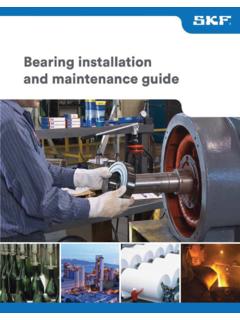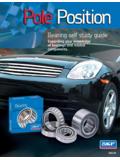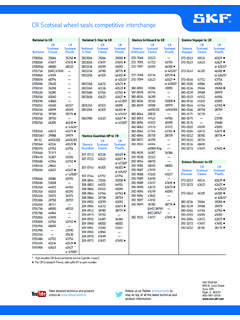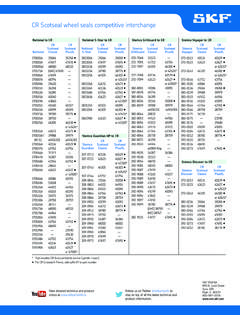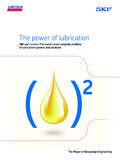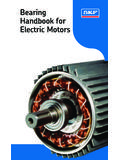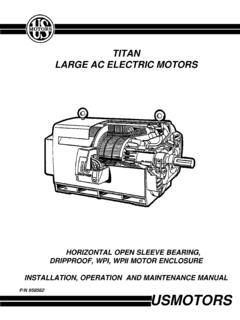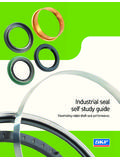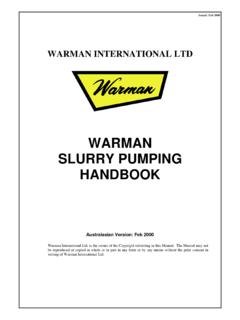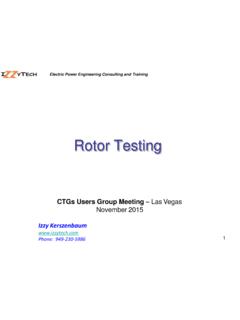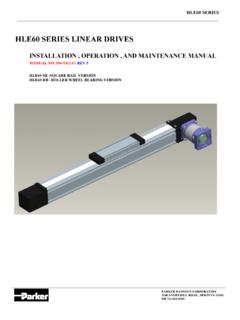Transcription of Bogie designs - SKF
1 Bogie designs Extract from the Railway technical handbook , volume 1, chapter 2, page 24 to 41 APX[fPh cTRW]XRP[ WP]SQ^^ZE^[d\T 0g[TQ^gTb fWTT[bTc QTPaX]Vb bT]b^ab R^]SXcX^] \^]Xc^aX]V bdQbhbcT\b P]S bTaeXRTbBogie design2 sDesign principles .. 25 Wheelset designs .. 29 Springs .. 32 Dampers .. 35 Bogie design examples .. 36 Earth return .. 4024 Bogie designsToday, very different Bogie design principles are applied. The main focus of this chapter are the Bogie features that are directly or indirectly related to the axlebox application. The main ones are Bogie design principle parameters, guiding / suspension, primary spring and damping principles that are interacting with the design of axleboxes and principlesA Bogie is a structure underneath a railway vehicle body to which axles and wheels are attached through bearings.
2 The term Bogie is used in British English, while a wheel truck , or simply truck is used in American English . The overall term is running gear , which covers bogies as well as vehicles with two, or more axles without any bogies . In this case, these axles are directly fitted to the vehicle body via guiding devices and springs, and for very low speeds even without springs .Running gears serve a number of purposes: support of the rail vehicle body stability on both straight and curved tracksproviding ride comfort by absorbing vibration, and minimizing centrifugal forces when the train runs on curves at high-speed minimizing generation of track irregularities and rail abrasion252 design principle elementsRailway bogies are complex subsystems in railway vehicles and contain brake systems, drive systems including gearbox coupling and traction motors for powered wheelsets, Bogie frames with secondary spring systems and the wheelset subsystems, which are basically the assembly of two wheels and an axle.
3 In this chapter, the focus is on some general Bogie design principles and especially design features that interact with the axlebox bearing system . Directly connected to the wheelset and the Bogie frame is the axlebox ( chapter 3) containing the axlebox bearing system ( chapter 4 and chapter 5) . The axlebox is very much linked to further subsystems and components like primary spring systems, axlebox guidance, dampers, steering mechanisms of wheelsets, earth return devices as well as sensors to detect operational parameters ( chapter 7) and Bogie monitoring systems ( chapter 8) .Further Bogie -connected subsystems are wheel flange lubrication systems, articulation joints, slewing bearings and special plain bearings for damper supports ( chapter 9).
4 Running gears and bogiesAll kinds of railway vehicles are equipped with running gears, which can be designed as 2- or 3-axle cars or as Bogie vehicles . 2-axle car design principles are used mainly for European freight cars, shunting locomotives and for sections of articulated cars such as low-floor light rail vehicles or tramways . Bogie designsToday, the majority of railway vehicles are equipped with bogies that contain mostly two axles, but in some cases, such as heavier and powerful locomotives, 3-axle designs are used . Because of the shorter axle distance of Bogie designs , longer vehicles/vehicle sections can be used . On the other hand, the riding comfort of Bogie vehicles is much better than vehicles equipped with axles that are supported directly by the vehicle body.
5 design principles of running gears and bogiesOn top: 2-axle vehicleMiddle and bottom: articulated vehicles based on 2-axle running gear designs applied for light rail vehiclesDesign principle of a Bogie vehicleJacobs Bogie design principleJacobs Bogie designsA common Bogie design principle, used especially for connected vehicle bodies for multiple units, special freight cars and mass transit vehicles, are Jacobs bogies1) . These bogies support two body ends via one Bogie . This design contributes to mass saving and running stabilization, resulting in a better riding performance for some applications .Example of a typical low-floor multi- section tramway design1) Jacobs bogies named after Wilhelm Jakobs (1858 1942) RailPivotAxlesBogies26 Powered Bogie designsLocomotives, multiple units such as high-speed trains as well as mass transit vehicles, are equipped with powered bogies.
6 Typical propulsion systems contain a wheelset, a gearbox and a traction motor . More sophisticated designs are equipped with hollow shafts and couplings to reduce un-sprung mass .Longitudinal propulsion (drive) systems contain a helical gearbox and cardan shafts . Hydraulic diesel propulsion systems contain mostly gearboxes and cardan shafts, connecting two Bogie drives to one main gearbox and the hydraulic gearbox system connected to the diesel motor .Powered Bogie , transverse drivePowered Bogie , longitudinal driveRadial steering principles To reduce the forces between rails and wheels, several radial steering design principles for wheelsets are applied . The aim of these designs is to reduce wear and noise caused by low steering forces.
7 designs with connected wheelsets and wheelsets connected to the vehicle body are based on lever systems that act on the wheelsets via the axleboxes .Radial steering principles for wheelsetsSelf steeringConnected wheelsetsWheelsets steered by the vehicle s body272 Wheelset arrangement classificationThe wheelset arrangement classification is a systematic tool to sort railway vehicles by position of the wheelsets (axles), bogies and connections of vehicle bodies . There are several notations used to describe wheelset and wheel arrangements, which vary by country . Within a given country, different notations may be employed for different kinds of locomotives, such as electric and diesel .The UIC classification scheme is widely used.
8 It is provided by the International Union of Railways and laid down in the UIC s Leaflet 650 Standard designation of axle arrangement on locomotives and multiple-unit sets .Upper-case letters designate a number of consecutive driving axles, starting at A for a single axle . C thus indicates three consecutive pairs of driving wheels . Numbers designate consecutive non- driving axles, starting with 1 for a single axle .Lower-case o designates axles, which are individually driven by electric traction motors in locomotives and multiple units . Prime sign indicates that the axles are mounted on a Bogie . Selection of practical examples:B B two bogies or wheel assemblies under the unit.
9 Each Bogie has two powered axles, connected by driving rods or gears . Bo Bo each Bogie has two individually-driven powered axles (i .e . via traction motors) . 75% of all modern locomotives (as well as the power cars of self-propelled trains) are configured as Bo Bo .Co Co two bogies or wheel assemblies under the unit . Each Bogie has three individually-driven, powered axles (i .e ., via traction motors) .Bo Bo + 2 2 + 2 2 multiple unit, first unit: two bogies, each Bogie has two individually-driven powered axles; second and third unit: two bogies, each Bogie with two non-powered axles .Bo 2 Bo articulated vehicle: first and last Bogie have two individually-driven powered axles / middle Bogie (Jacobs design ) with two non-powered axles.
10 Wheelset arrangement examplesB B Bo Bo Co Co Bo Bo + 2 2 + 2 2 Bo 2 Bo Un-powered wheelsetPowered wheelsetMotor28 Wheelset designsRailway gaugeThe gauge is the distance between the two wheel flanges, corresponding to the distance between the inner sides of the rails . Examples of widely used railway gauges:standard gauge 1 435 mm (4 ft. 8 1/2 in.), comprises around 60% of total world track length broad gauges, which are larger than standard gauge e .g . Russian broad gauge 1 520 mm (17%), Indian broad gauge 1 665 mm (5 ft. 6 in.) and Iberian broad gauge 1 668 mm (5 ft. 5 2 3 in.), together comprise 9% of total world track length narrow gauges, which are smaller than standard gauge e.
